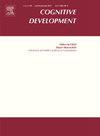Development of inequity aversion in argentine children in different SES populations
IF 1.8
3区 心理学
Q3 PSYCHOLOGY, DEVELOPMENTAL
引用次数: 0
Abstract
Inequity aversion, which can be categorized into disadvantageous inequity aversion and advantageous inequity aversion, does not develop in the same way across different societies and cultures. In the current study, we evaluated inequity aversion using the "inequity game" among Argentine children from two different populations: a low socioeconomic status (SES) group (n = 168) and a middle socioeconomic status group (n = 129). Middle-SES children showed stronger signs of disadvantageous inequity aversion and showed signs from an earlier age than low-SES children, but neither group showed advantageous inequity aversion. On the other hand, girls tended to manifest greater levels of advantageous inequity aversion than boys, while boys manifested greater disadvantageous inequity aversion than girls. These results indicate that the phenomenon of inequity aversion not only varies between different cultures and countries but also manifests differently within the same society.
不同社会经济地位人群阿根廷儿童不平等厌恶情绪的发展
不平等厌恶可以分为不利的不平等厌恶和有利的不平等厌恶,但在不同的社会和文化中,不平等厌恶的发展方式并不相同。在当前的研究中,我们使用“不平等游戏”来评估来自两个不同人群的阿根廷儿童的不平等厌恶程度:低社会经济地位(SES)组(n = 168)和中等社会经济地位组(n = 129)。中等社会地位儿童比低社会地位儿童表现出更强的不利不公平厌恶迹象,并且表现出更早的年龄,但两组都没有表现出有利的不公平厌恶。另一方面,女孩比男孩更倾向于表现出有利的不平等厌恶,而男孩比女孩表现出更大的不利的不平等厌恶。这些结果表明,不平等厌恶现象不仅在不同文化和国家之间存在差异,而且在同一社会内部也有不同的表现。
本文章由计算机程序翻译,如有差异,请以英文原文为准。
求助全文
约1分钟内获得全文
求助全文
来源期刊

Cognitive Development
Multiple-
CiteScore
3.20
自引率
5.60%
发文量
114
期刊介绍:
Cognitive Development contains the very best empirical and theoretical work on the development of perception, memory, language, concepts, thinking, problem solving, metacognition, and social cognition. Criteria for acceptance of articles will be: significance of the work to issues of current interest, substance of the argument, and clarity of expression. For purposes of publication in Cognitive Development, moral and social development will be considered part of cognitive development when they are related to the development of knowledge or thought processes.
 求助内容:
求助内容: 应助结果提醒方式:
应助结果提醒方式:


